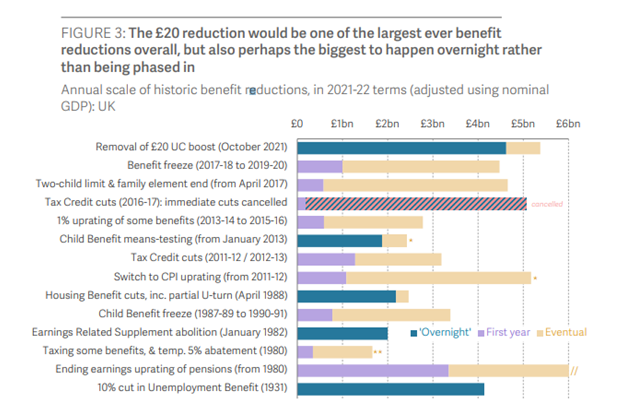The SDLP manifesto for the 2022 Assembly election claims: “The £20 Universal Credit cut marked the largest overnight welfare cut since World War II.”
This is accurate, with some provisos – mainly that making economic comparisons between different moments in time can be tricky.
What are the facts?
Overnight cut
In October 2021 the UK government decided to remove the £20 ‘uplift’ in benefits payments that had been in place for around 18 months since the beginning of the pandemic.
In July 2021, anticipating the uplift’s removal, the Joseph Rowntree Foundation (JRF UK) published an analysis of the impact of cutting benefits payments by £20 every week.
The organisation also published an article with a headline claiming the UK was “heading for the biggest overnight cut to the basic rate of social security since WWII”.
However, its analysis focused on the period after the formation of the modern welfare state, three years after the end of the war.
So, their work actually calculated that this would be the biggest overnight cut to benefits since 1948, not 1945.
JRF UK said: “We have reviewed officially published data on rates of benefits stretching back to 1948 (when the Beveridge system was introduced), in particular, the main element of support for a single adult aged over 25 who has lost their job. It is possible that the cut this October could be the biggest cut ever, though we have not looked in detail at the period before 1948.”
Is more information available?
Wider look
In September 2021, The Resolution Foundation carried out its own analysis of the impact of the £20 cut, which it described as “one of the largest ever benefit reductions overall” and “perhaps” also “the biggest to happen overnight”.
It found that some other adjustments have led to, or will lead to, larger reductions over time – but those involve gradual changes. The removal of the uplift represents the biggest overnight, incremental cut.

Figure 3 (above) is taken from, T. Bell, A. Corlett and D. Tomlinson, “Briefing: To govern is to choose The choices facing the Chancellor this autumn” (Resolution Foundation, 2021:12).
What is clear is that TRF’s report made an effort to also consider the period 1945-48 and, despite some circumspection, it goes at least as far as the JRF UK analysis in how it frames the uplift’s removal.
The paper says: “The scale of the impact of this decision is hard to overstate: if the Chancellor goes ahead with this cut, it would be the largest overnight benefit reduction that has ever happened.”
Caveats
Comparisons between moments across such a long period of time are difficult and involve accounting for inflation and other factors.
The structure of the social security system has also changed over the years, which is an added complication. Indeed, the UK’s modern welfare state was only established in 1948, although some government support existed before then.
In its analysis, the Resolution Foundation advised that the 20th century costings it used – particularly those for 1931, the Child Benefit freeze and State Pension uprating – should be “treated as approximate at best given the limited sources available”.
However, these are standard challenges when making any economic comparisons between different periods of time.




